Free Asian Recipes from Malaysia for Cooking Malaysian Food
Malaysian Recipes, Malay recipe, Malaysian Food, Malaysian Cooking - delicious recipes from Malaysia handed down from my mother's secret recipe stash & friends.
| Chicken Recipes | Beef Recipes | Seafood Recipes | Vegetarian Recipes | Dessert Recipes |
This page contains smaples of famous wide-ranging assortment of recipes of multi-cultural Malaysia. Here you will find recipes originating from Nyonya and Mamak specialities. As Malaysia is filled with different cultures, it does not come as a surprise to find many delightful dishes ranging from Malay to Chinese to Indian cuisine.
 Background:
Background:
Nyonya Food is peculiar to only the Chinese of Penang, Malacca and Singapore. Now I love Nyonya food,
having grown up with this cooking. My mother learnt from her mother and I am proud to say that I've learnt
quite a lot from these remarkable women. I must say, it does take a lot of getting used to the cooking methods. My
mother would be famous is saying 'you just have to guess and get a feel for it'. Luckily, I watched her
and measured whatever she put into her cooking so I am now proud to include the measurements in this website.
Be aware, though, I may not be exact so you may have to adjust your measurement. Examples of Nynonya style
food include;
Cendol,
Penang Laksa, pie tie, kuih ketayap and
kuih lapis.
Malay Food typically uses a lot of coconut milk, chillies and belacan. With coconut milk and cream, you would need to be careful because they contain a lot of calories and is high in cholesterol. To avoid this problem, use coconut milk instead of cream. Nothing is complete without the addition of chillies to the Malay cuisine and I love all types of chillies. Be sure to de-seed and remove the membranes from the chillies (wear gloves!) if you do not wish your food to be extra spicy. Note that dried chillies are actually more potent than fresh ones (except bird-eye chillies). Shrimp belachan is wonderful (see description below in glossary) but the smell can penetrate the house so be sure to open all your windows when you do dry-roast them. Grind them up aftewards then store in an air-tight container and keep in the refrigerator. Examples of Malayan dishes include; nasi lemak, chicken satay, ketupat, beef rendang, Spicy Belchan Prawns and many more.
In the northern states of Kedah, Perlis, Penang and Kelantan, you would find the flavors Thailand in the cuisine. There is a hint of fragrant sourness that is often associated with the use of tarmarind, sour carambola and limes as well as hotness of chillies (Thai) that is so popular in northern Malaysian cuisine. Another popular dish is the Nasi Ulam or Kerambu which is a rice dish that is cooked with pandan, galangal, lemongrass and kaffir lime leaves and a mixture of other herbs and spices.
Chinese Food in Malaysia differs slightly than what you would normally find in a typical Chinese restaurant. In Malaysia, the Chinese cuisine shares many similar cooking method with that of Singapore so it is not unusual to find many dishes that are a blend of both. However, the Chinese dishes of Malaysia is different from that of China or Hong Kong because they are influenced from Malaysia's neighbor to the north, Thailand as well as Malaysian and Indian cuisine. Examples include; ham choy soup, char koay teow, steam fish, black pepper crabs and many more.
The Chinese also place a great importance on the contrast of lively colors, flavors and texture in their cuisine. There are Cantonese, Sichuan, Hokkien, Teochew, Hockchew, Foochow, Hakka, Hainanese and Hunghua influences in Chinese cooking. When travelling to Malaysia, it is often noted that the Chinese people always seem to bea eating. That is because food plays an important role in the Chinese family where meal time is seen as a gathering of family and the renewal of family ties.
Indian Food in Malaysia has a unique and wonderful flavor altogether. It is a blend of southern and northern Indian cuisine with influences from Malay and Chinese cooking alike. I love the Indian curry with its thick coconut flavor and the spiciness of chillies that come with it. Our housekeeper was a wonderful Indian cook who would always make us curry every week and even snuck in a couple of desserts every so often. Examples of Indian food include; lamb curry, mutton kurma, dhal or lentil dish, roti canai and so much more.
If you were to go into an Indian restaurant, you might find yourself at a table where the plate is a banana leaf. Indian cuisine, especially from the south where most of Malaysian Indians originate, share some similarities with Malay cooking. Because they share a lot in common, you would not find pork in most Indian restaurant. Apart from Roti Canai, you can also find great Indian dishes like Indian Mee Goreng, Mee Siam and Mutarbak which is a type of pancake that is filled with onion and minced chicken or mutton.
I hope you will enjoy making Malaysian cooking as much as I do. The recipes below are mere guidelines so feel free to experiment and adjust to your own palate and taste.
To learn more about Malaysia, visit the Tourism Malaysia Website.
Malaysian Recipes
-
Index of New Malaysian Recipes:
- Chicken Giblets Curry (Gulai Pak Lai) NEW
- Mutton and Potato Curry NEW
- Sweet Peanut Broth (Thor Tau Ting) NEW
- Barley Drink (Ee Bee Chui) NEW
-
Nyonya Pork Floss (Bak Hoo) NEW
Malaysian Chicken, Duck, Quail & Poultry Recipes:
- Chicken Satay popular
- Chicken Steamed with Black Mushroom
- Grilled Chicken with Spicy Peanut Sauce
- Hainanese Roast Chicken with Rice popular
- Kari Ayam (Chicken curry) popular
- Spicy Kelantan Chicken popular
-
Stuffed Duck's Feet
Malaysia Pork, Mutton, Beef, Veal and Lamb Recipes
- Beef Rendang popular
- Bergedel Goreng (Fried Meat Patties)
- Char Siew (Barbeque Pork) popular
- Glutinous Rice in Bamboo Leaves (Chung) popular
- Lamb Curry in Coconut Cream
- Mutton Kurma
-
Popiah or Sutffed Pancake Rolls popular
Malaysian Seafood Recipes
- Abalone Soup
- Black Pepper Crabs
- Chinese Steamed Fish popular
- Crab with Tomato Sauce
- Cucur Udang (Prawn fritters)
- Fish with Pineapple
- Ikan Panggang (Grilled Fish) popular
- "Shark fin" Soup or Imitation Shark Fin Soup popular
- Satay Fish Balls
- Spicy Belachan Prawns popular
- Vegetables with Prawns and Beef in Coconut Gravy
-
Yong Tau Foo (Vegetables with Stuffed Fish Paste) popular
Malaysian Vegetarian Recipes
- Acar (Malaysian Pickle) popular
- Brinjal Sambal (Keoh Char Huan Cheo)
- Dhal (Lentils dish)
- Fried Egg with Chilli
- Gado Gado or Mixed Vegetables with Peanut Sauce popular
- Spicy Okra Kheema
-
Spicy Pumpkin
Malaysia Noodles, Rice & Bread Recipes
- Char Koay Teow (Fried rice noodles) Penang Style - UPDATED popular
- Hokkien Mee (Soup noodle Hokkien style) popular
- Indian Fried Noodles (Mee Goreng)
- Malay Fried Rice (Nasi Goreng)
- Mee Rebus popular
- Mee Siam
- Nasi Lemak (Coconut flavoured rice dish) popular
- Koay Teow T'ng (Rice noodle soup) popular
- Lontong (Malay Compressed Rice)
- Penang Laksa (Penang sour spicy noodles) popular
- Roti Canai popular
- Roti Jala (Malaysian Crepes) popular
- Sar Hor Fun (Noodles in Chicken Broth) popular
-
Steamed Rice with Screwpine Leaves (Nasi Ambang)
Malaysian Dessert & Sweets Recipes
- Ang Ku (Festive Nyonya Cakes) popular
- Cendol (Malaysian Sweet Iced Dessert) popular
- Kuih Bingka (Baked tapioca cake) popular
- Kuih Kosui or Malay Steamed Rice Pudding
- Kuih Lapis (Layered cakes) popular
- Kuih Talam popular
- Murukku (Deep Fried Indian Biscuits)
- Pancakes with Sweet Coconut Filling (Kuih Dadar)
- Pandan Chiffon Cake popular
- Rice Vermicelli in Sugar Syrup (Mee Suah Chu T'ng)
- Seri Muka or Nyonya Steamed Glutinous Pandan Rice Cake popular
- Shaved Ice with Red Beans (Ice Kachang) popular
-
Soy bean milk popular
Chicken Recipes
Beef & Pork Recipes
Seafood Recipes
Vegetarian Recipes
Dessert Recipes
 A gum derived from a Persian plant that is used in tiny amounts in Indian cooking to give it flavor.
Available in small rectangular blocks from Indian spice shops. Also known as hing in India
and perankayam in Tamil.
A gum derived from a Persian plant that is used in tiny amounts in Indian cooking to give it flavor.
Available in small rectangular blocks from Indian spice shops. Also known as hing in India
and perankayam in Tamil. Thinly sliced and dried until shirvelled and brownish black. Widely grown in tropical & sub-tropical climate.
Tamarind fruit and leaves have reported to have medicinal qualities.
Thinly sliced and dried until shirvelled and brownish black. Widely grown in tropical & sub-tropical climate.
Tamarind fruit and leaves have reported to have medicinal qualities.
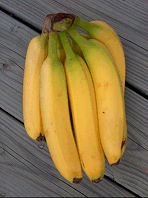 In most savory dishes, non-sweet bananas similar to plantains are sued (e.g. pisang kepok, pisang kari,
pisang nipah). Be sure not to subsitute with sweet dessert bananas. Banana leaf is frequently used
to wrap cakes and fish. Foil can be subsituted in most cases but you will miss out on the flavor.
In most savory dishes, non-sweet bananas similar to plantains are sued (e.g. pisang kepok, pisang kari,
pisang nipah). Be sure not to subsitute with sweet dessert bananas. Banana leaf is frequently used
to wrap cakes and fish. Foil can be subsituted in most cases but you will miss out on the flavor.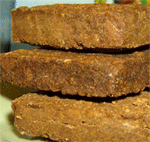 Common use in Thailand, Singapore and Malaysia as flavouring for vegetables. Indispensable dish in
Nyonya cuisine. Made
from red chillie, roasted balacan and kalamansi. If using this, it is better to roast it in a toaster oven
or in a pan before adding unless used as part of a paste otherwise flavor will be bitter. Be aware than
when you are doing this, will emit a smell so open all windows and use a well-ventilated area.
Common use in Thailand, Singapore and Malaysia as flavouring for vegetables. Indispensable dish in
Nyonya cuisine. Made
from red chillie, roasted balacan and kalamansi. If using this, it is better to roast it in a toaster oven
or in a pan before adding unless used as part of a paste otherwise flavor will be bitter. Be aware than
when you are doing this, will emit a smell so open all windows and use a well-ventilated area.
 Mixed with various herbs and powder will produce varying flavours, mixed with water will produce a hotter and
sharper flavour. Mixing with vinegar gets you milder effect. Prevent biji sawi from deteriorating by cooking it in hot oil
until it turns crisps.
Mixed with various herbs and powder will produce varying flavours, mixed with water will produce a hotter and
sharper flavour. Mixing with vinegar gets you milder effect. Prevent biji sawi from deteriorating by cooking it in hot oil
until it turns crisps.
 Native to India and Southeast Asia, the fruit is a small capsule with 8 to 16 brown seeds; the seeds
are used as a spice. Available at most Indian grocery stores. Store in a cool, dry place, away from any
moisture.
Native to India and Southeast Asia, the fruit is a small capsule with 8 to 16 brown seeds; the seeds
are used as a spice. Available at most Indian grocery stores. Store in a cool, dry place, away from any
moisture.
 Fruits of the Candlenut, Candle-berry, or Varnish tree from India, Phillipine and Pacific Islands. Copntains
large amount of of oil, will become rancid if kept too long. Toxin found in nuts unsuitable for eating raw but
vanishes during cooking. Subsitute: macadamia or cashew nuts
Fruits of the Candlenut, Candle-berry, or Varnish tree from India, Phillipine and Pacific Islands. Copntains
large amount of of oil, will become rancid if kept too long. Toxin found in nuts unsuitable for eating raw but
vanishes during cooking. Subsitute: macadamia or cashew nuts
 The hottest variety is known as birds-eye chilli or chilli padi (birds eye chillies) and are about 2 cm long.
Chill-tairu are green chillies preserved in salted yogurt, store in tins and usually deep-fry
in hot oil for a few seconds before use.
The hottest variety is known as birds-eye chilli or chilli padi (birds eye chillies) and are about 2 cm long.
Chill-tairu are green chillies preserved in salted yogurt, store in tins and usually deep-fry
in hot oil for a few seconds before use.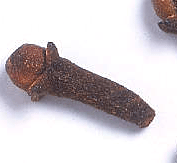 Myrtle family. Very strong, aromatic and intense flavour. Use sparingly. Medicinal properties: warm spleen
and stomach. Used in many Asian dishes from curry to flavoring tea.
Myrtle family. Very strong, aromatic and intense flavour. Use sparingly. Medicinal properties: warm spleen
and stomach. Used in many Asian dishes from curry to flavoring tea.
 Wonderful fragrant leaf from a variety of citrus. Any young citrus leaves can be subsituted though
their flavor is nowhere near as lovely and fragrant. Can be bought fresh then freeze in freezer and taken out
as needed.
Wonderful fragrant leaf from a variety of citrus. Any young citrus leaves can be subsituted though
their flavor is nowhere near as lovely and fragrant. Can be bought fresh then freeze in freezer and taken out
as needed.
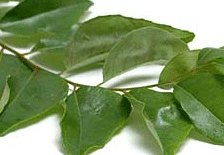 Used abundantly by South Indian cooks, curry leaves (karuvapillai in Tamil) must not be confused
with Indonesian daun salam, a type of bay leaf. Curry leaves are about 1 inch long, dark green in
color and have a pungent smell. Dried leaves can be used if fresh ones are not available.
Used abundantly by South Indian cooks, curry leaves (karuvapillai in Tamil) must not be confused
with Indonesian daun salam, a type of bay leaf. Curry leaves are about 1 inch long, dark green in
color and have a pungent smell. Dried leaves can be used if fresh ones are not available.  Also known as palm sugar. It is a hard brown sugar block made from the sap of the aren palm. If
not available, subsitute with soft brown sugar with a touch of maple syrup.
Also known as palm sugar. It is a hard brown sugar block made from the sap of the aren palm. If
not available, subsitute with soft brown sugar with a touch of maple syrup. The Malay name for this vegetable is terong and the Indian name is brinjal. The Asian
varities are much smaler than European eggplant or aubergine. Another variety is the longer Asian eggplant
also known as Chinese Egg Plant.
The Malay name for this vegetable is terong and the Indian name is brinjal. The Asian
varities are much smaler than European eggplant or aubergine. Another variety is the longer Asian eggplant
also known as Chinese Egg Plant. Also known as stir-fry noodles, these are fresh egg noodles that resemble thick yellow brown spaghetti
that does not need to be pre-cook before use.
Also known as stir-fry noodles, these are fresh egg noodles that resemble thick yellow brown spaghetti
that does not need to be pre-cook before use.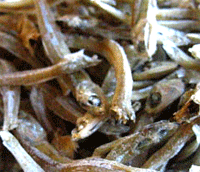 Range in sizes from very tiny varities (known as silver fish) to the larger variety often about
2 cm long. If using large, you must discard the heads and intestine otherwise it will leave a bitter flavor.
Fish have to be salted before dried. Before using ikan bilis, you should wash them under cold water then
put them out to dry otherwise it will leave a salty residue on your tongue.
Range in sizes from very tiny varities (known as silver fish) to the larger variety often about
2 cm long. If using large, you must discard the heads and intestine otherwise it will leave a bitter flavor.
Fish have to be salted before dried. Before using ikan bilis, you should wash them under cold water then
put them out to dry otherwise it will leave a salty residue on your tongue.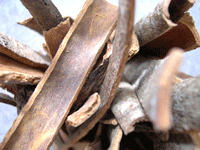 Cinnamon sticks are made from long pieces of bark that are rolled, pressed, and dried. Most common
in dried powder form. Storage: Cool, dry and dark places. Do not boil dry form - will loose flavour.
Can be bought in bark pieces as well.
Cinnamon sticks are made from long pieces of bark that are rolled, pressed, and dried. Most common
in dried powder form. Storage: Cool, dry and dark places. Do not boil dry form - will loose flavour.
Can be bought in bark pieces as well.
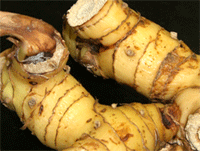 Available in many forms: fresh, dried, frozen, powdered (small quantities only). Ginger may be subsituted but
recipe may loose some flavours. Indonesian name is laos. If using in peices, remove from dish before
serving.
Available in many forms: fresh, dried, frozen, powdered (small quantities only). Ginger may be subsituted but
recipe may loose some flavours. Indonesian name is laos. If using in peices, remove from dish before
serving.
 2 types of limes: large green lime (shaped like lmeon) and small round lime which is known as limau kesturi.
The small lime has more fragrance. Subsitute with half-ripe kumquats if possible, otherwise use lemon juice.
2 types of limes: large green lime (shaped like lmeon) and small round lime which is known as limau kesturi.
The small lime has more fragrance. Subsitute with half-ripe kumquats if possible, otherwise use lemon juice.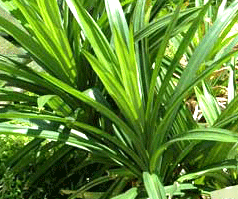 Very versatile, common in many Malaysian cooking. Used for coloring and flavouring (slightly nutty)
of desserts and cakes. From the screwpine family. Easily grown in a tropical garden.
Very versatile, common in many Malaysian cooking. Used for coloring and flavouring (slightly nutty)
of desserts and cakes. From the screwpine family. Easily grown in a tropical garden.
 Lemon scented herb. The whitish stem can be used for seasoning. Mashing or chopping up this herb before
cooking will spread the flavour.
Lemon scented herb. The whitish stem can be used for seasoning. Mashing or chopping up this herb before
cooking will spread the flavour.
 A wonderful evocative flavor with Arabian origin. Used in some Indian and Malay dishes. If you are using
the concentrated rose essence, be sure to use less the amount required than rose water which is diluted.
A wonderful evocative flavor with Arabian origin. Used in some Indian and Malay dishes. If you are using
the concentrated rose essence, be sure to use less the amount required than rose water which is diluted.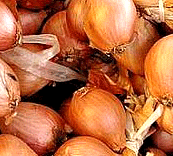 Malay name is bawang merah meaning 'red onion' for these pinkish-purple marble sized onions. Taste
slightly 'sweeter' than the bigger variety.
If not available, use the purple Bombay onions or the brown skinned onions.
Malay name is bawang merah meaning 'red onion' for these pinkish-purple marble sized onions. Taste
slightly 'sweeter' than the bigger variety.
If not available, use the purple Bombay onions or the brown skinned onions.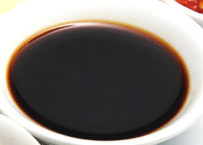 2 types: light thin soy sauce and thick dark soya sauce. Dark and light soy sauce are used for
seasoning. The light sauce is generally saltier than the dark and is used in stir-fries and with light
meats. The dark soy sauce adds a rich flavor and color to braised and red meat dishes and is generally
thicker in texture.
2 types: light thin soy sauce and thick dark soya sauce. Dark and light soy sauce are used for
seasoning. The light sauce is generally saltier than the dark and is used in stir-fries and with light
meats. The dark soy sauce adds a rich flavor and color to braised and red meat dishes and is generally
thicker in texture.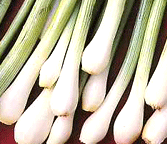 Slender green stalks with a white base. Not to be confused with shallots which are small
round pink onions. Use as part of a dish or as garnish, spring onions are the mainstay in Malaysian
cuisine.
Slender green stalks with a white base. Not to be confused with shallots which are small
round pink onions. Use as part of a dish or as garnish, spring onions are the mainstay in Malaysian
cuisine.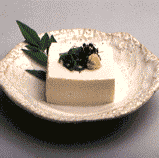 Soya bean is one of the most versatile products in Asia. Made from soya bean and is available in
several forms. Firm tofu is known as taukwa, soft tofu is tahu and dried bean curd
skins is fu chook in sticks or tin chook in sheets.
Soya bean is one of the most versatile products in Asia. Made from soya bean and is available in
several forms. Firm tofu is known as taukwa, soft tofu is tahu and dried bean curd
skins is fu chook in sticks or tin chook in sheets. Also known as jicama is a cunchy white vegetable. Known as bangkwang in Malay. Has
a flavor that is a crossed between apple and potato. If none is available or out of season, you can usually
subsitute with canned water chestnuts.
Also known as jicama is a cunchy white vegetable. Known as bangkwang in Malay. Has
a flavor that is a crossed between apple and potato. If none is available or out of season, you can usually
subsitute with canned water chestnuts. Young Ginger
Young Ginger